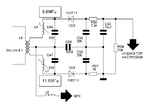DavidYebadlo
Junior Member level 1
Hi All,
The aim of the task is to design a FM demodulator in a ratio detector. I've been trying to do this for several hours but I have a feeling that still isn't it. I am asking for help and suggestions on what should be improved in the system. I also send the layout diagram in LTspice and characteristics


Blue plot is output voltage and yellow is input voltage.
The aim of the task is to design a FM demodulator in a ratio detector. I've been trying to do this for several hours but I have a feeling that still isn't it. I am asking for help and suggestions on what should be improved in the system. I also send the layout diagram in LTspice and characteristics
Blue plot is output voltage and yellow is input voltage.


